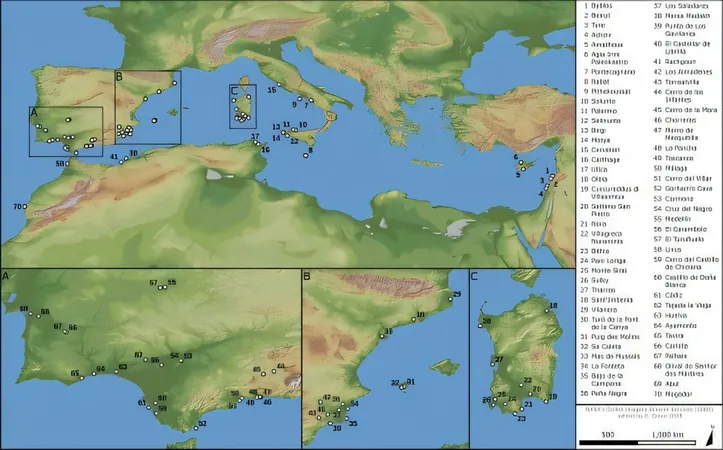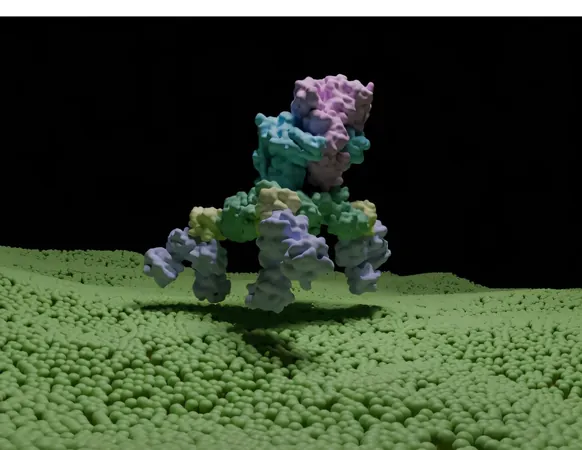
Unlocking Ancient Scents: How Phoenician Oil Bottles Illuminate Iron Age Identity
2025-08-25
Author: Mei
Diving into the Aromatic Past
While pottery shards and bones may endure for ages beneath the earth, the tantalizing aromas of our ancestors often fade into oblivion. However, groundbreaking research has finally unearthed these lost scents from antiquity. A dedicated interdisciplinary team has meticulously analyzed 51 ceramic oil vessels from the ancient Phoenician settlement of Motya, nestled on a picturesque island off Sicily's shores.
Scent: A Bridge to Identity and Culture
This seminal study, spearheaded by researchers from the University of Tübingen and the Complutense University of Madrid, uncovers the profound significance of scent in shaping identity and fostering cross-cultural exchanges during the Iron Age Mediterranean. Published in the prestigious Journal of Archaeological Method and Theory, their findings reveal how these ancient aromas played a central role in the daily lives and memories of Mediterranean peoples.
The Vessels: Portals to the Past
The examined vessels, modest in size yet rich in history, stand between 15.5 and 18.5 cm tall and date back to between the 8th and 6th centuries BCE. Typically discovered in tombs, family homes, and sacred sites, Dr. Adriano Orsingher notes, "Their widespread presence across the Mediterranean hints at a variety of purposes and significances."
From Production to Provenance
Through rigorous analysis, the research team traced the vessels' origins to southern Phoenicia, particularly the areas around present-day Beirut and the Carmel region. They uncovered organic residues in eight of the vessels, revealing enticing traces of plant-based lipids and aromatic substances like pine and mastic resin—crucial indicators of their fragrant contents.
Smells of Home: Connecting Cultures
Amicone, a co-researcher, states, "Our research confirms these ceramic vessels were integral in transporting aromatic oils." More than mere commodities, these oils acted as cultural bridges, carrying the essence of familiar scents as Phoenician migrants journeyed across the Mediterranean. Such aromas reinforced communal ties and shared experiences among dispersed populations.
Redefining Ancient Mobility
The Mediterranean during the Iron Age was a vibrant tapestry of mobility and cultural intermingling. Central to this dynamic were the Phoenicians, renowned for their seafaring and trading prowess. The production and exchange of aromatic substances were pivotal to their cultural practices—both for local usage and export.
Scent and Cultural Exchange: A New Perspective
This study urges a re-evaluation of ancient trade and migration, emphasizing that such movements were not merely about goods but also the circulation of scents, memories, and traditions. As Orsingher succinctly puts it, "Scent is deeply intertwined with identity and plays a crucial, though often neglected, role in migration, settlement, and cultural exchange."
Interdisciplinary Insights into Antiquity
Amicone reflects on the potential of interdisciplinary research: "By investigating what these vessels contained and their societal roles, we gain invaluable insights into how scents intertwined lives and identities in the ancient Mediterranean."
A New Lens on History
Professor Karla Pollmann, President of the University of Tübingen, underscores the importance of innovative research methods in unveiling unexpected aspects of our past: "This study illustrates that elusive traces like ancient scents can be decoded through interdisciplinary approaches, offering fresh perspectives on the sensory and cultural dimensions of antiquity."


 Brasil (PT)
Brasil (PT)
 Canada (EN)
Canada (EN)
 Chile (ES)
Chile (ES)
 Česko (CS)
Česko (CS)
 대한민국 (KO)
대한민국 (KO)
 España (ES)
España (ES)
 France (FR)
France (FR)
 Hong Kong (EN)
Hong Kong (EN)
 Italia (IT)
Italia (IT)
 日本 (JA)
日本 (JA)
 Magyarország (HU)
Magyarország (HU)
 Norge (NO)
Norge (NO)
 Polska (PL)
Polska (PL)
 Schweiz (DE)
Schweiz (DE)
 Singapore (EN)
Singapore (EN)
 Sverige (SV)
Sverige (SV)
 Suomi (FI)
Suomi (FI)
 Türkiye (TR)
Türkiye (TR)
 الإمارات العربية المتحدة (AR)
الإمارات العربية المتحدة (AR)